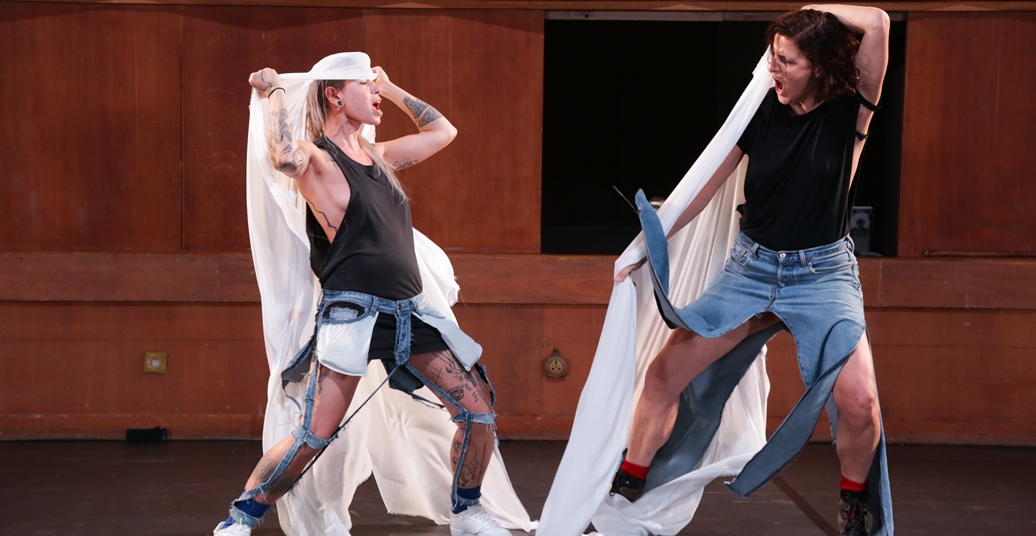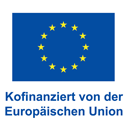Choreographer Yasmeen Godder and collaborative partner Tomer Damsky return to the Potsdamer Tanztage with their work of political and sonic force, “Demonstrate Restraint”.
Things I will remember: sticks flying on drums; her body shielded; the multitudinous variations of a white drape; the sweet sonic plateaus of auto-tune; flesh; torn jeans; chaos. And, of course, that beautiful title – “Demonstrate Restraint” – two words unfurling as both a command and a juxtaposition.
A command and a juxtaposition – these ideas, indeed, seem to be at the heart of choreographer Yasmeen Godder’s 2018 project, a collaboration with musician, vocalist, and composer Tomer Damsky. The piece aims to embody and challenge the symbols of Israeli politics. Created with the support of Israeli institutions in Jerusalem and French partners in Toulouse and Rennes, Godder and Damsky’s work is both a real grappling with the production and manipulation of political images, as well as a formidable study in interdisciplinary potential.
Staged at the T-Werk studios at Potsdam´s Schiffbauergasse site, the audience is greeted by a disorienting, green-lit space. Godder and Damsky appear on stage to a collaborative drum-beat, the rhythm of which becomes a common metre. Working with the objects on the stage – drums sticks, a pole, fabric, and sculptures of human limbs – Godder transforms a white flag into a matador’s muleta; the banner of a happy, running athletics champion; the cape and apron of a folk dancer; and, perhaps not unpredictably, the simple and poignantly stark flag of surrender.
Damsky and Godder take turns creating noise and making shapes, running and stopping on stage, shouting, panting, and transforming themselves and their environs. While Damsky takes charge of the most layered musical moments (live looping, souped up auto-tuning, and a drum solo), Godder is wonderfully active in her vocalisations and sonification of objects. And while it is Godder who carries off the periods of extended solo dancing, Damsky’s physicality bears equal weight, power, and interest to that of Godder’s. It is a brilliant combination in which the visual and auditory flow easily within and between the two.
Godder and Damsky sing, shout, and dance together, while at other times they pass off the rhythm – that is to say, the power – between each other in an extended, exhausting pas de deux. As Roland Barthes expressed: “There is an inextricable link between power and rhythm. What power imposes in the first place is a rhythm (rhythm of everything – life, time, thought, discourse).”1 Think of the eight hour sleep schedule, born in industrial capitalism, or the form-content construction of the length of a tweet. Here, Damsky and Godder give us a different rhythm, one which passes relentlessly between two sets of hands, two minds, two contexts, two histories.
Rhythm is ever present, and yet, sometimes, still catches us unaware: a striking moment builds when Damsky lies on the ground, classically reclined, displaying before us a collection of tape recorders. Each plays back the reverberating howls just previously captured. As the screams layer one on top of the other, they alternately produce cacophony, and, perhaps more unsettlingly, euphony, as the pitches find incidental harmonies as they move in and out of time. Later, Damsky sings: “Everybody knows it / but nobody is telling me / I have no right to exist / god knows,” as she saunters melancholically around the stage amidst beats and fog. At one point, the two performers don veils, as brides or weeping widows, before tying them up into a keffiyeh, the traditional male headdress found in parts of the Middle East. For a flash of a second, a bizarre amalgamation of Tupac and Mary Wigman passes before my eyes, then Damsky grabs Godder, and I see a woman dragged by her hair through the dust. Images cannot be relied upon.
Power shifts. Godder breaks the fourth wall, greeting the audience, dedicating three dances to three individuals and asking us all to share our associations in a collaborative exegesis. With the play of words and images in mind, Godder takes up the white flag once more, bringing together two sticks to prop it up as a small tent. Damsky joins her beneath it. But soon enough they are off again, marching in a circle, the two white triangles with their flowing tails forming a horrifying silhouette, reminiscent of the KKK in the night. This problem, it seems to say, is bigger than our town.
As the two performers encircle the space, chanting, my eyes become blurry, slipping from seeing them as protestors to crusaders, victims to aggressors, the righteous to the terrible, back and forth, back and forth. At last, to make the point crystal clear, Godder takes up a mucousy, translucent sculpture from the floor – an enlarged bust split frontally. She wears its, super-sizing her front half, transforming into a bionic soldier with a harrowingly real presence. Then, the next moment, she is underneath it, crouched small on the floor, beneath whatever shelter she can find.
As the piece draws to a close, Damsky screams at us through her sound, and more than anything, I feel like I have been through an intellectual exercise – a series of rapid, Gestalt shift tests. When the performers take their bows, I feel the force of two women, of friendship, of sweat and effort and compromise and risk – I register an emotional pulse during this moment that I missed the whole of the stimulating, intense, and challenging last hour. There’s much I will remember – shapes and cracks of voices, the thud of a hard run – and a great deal that I can structurally recall and verbalise, but it is still not totally clear to me how the two sides of this piece sew together. But maybe that’s the point. What does it mean to ‘see something as something’?2 A juxtaposition and a command. Perhaps it is through this question that we find a pathway to understanding art, and to understanding politics.




